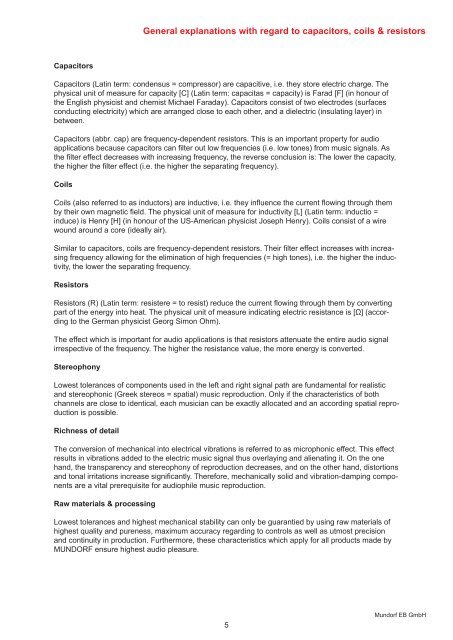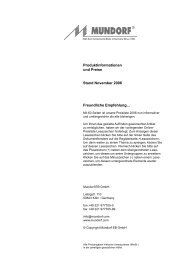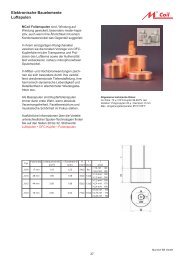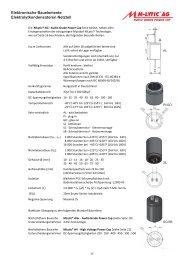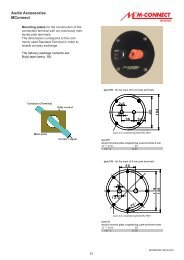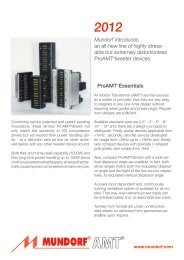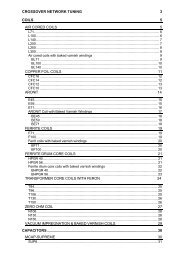26 Years for the Love of Music. Fidelity ... - Mundorf EB GmbH
26 Years for the Love of Music. Fidelity ... - Mundorf EB GmbH
26 Years for the Love of Music. Fidelity ... - Mundorf EB GmbH
You also want an ePaper? Increase the reach of your titles
YUMPU automatically turns print PDFs into web optimized ePapers that Google loves.
Capacitors<br />
General explanations with regard to capacitors, coils & resistors<br />
Capacitors (Latin term: condensus = compressor) are capacitive, i.e. <strong>the</strong>y store electric charge. The<br />
physical unit <strong>of</strong> measure <strong>for</strong> capacity [C] (Latin term: capacitas = capacity) is Farad [F] (in honour <strong>of</strong><br />
<strong>the</strong> English physicist and chemist Michael Faraday). Capacitors consist <strong>of</strong> two electrodes (surfaces<br />
conducting electricity) which are arranged close to each o<strong>the</strong>r, and a dielectric (insulating layer) in<br />
between.<br />
Capacitors (abbr. cap) are frequency-dependent resistors. This is an important property <strong>for</strong> audio<br />
applications because capacitors can fi lter out low frequencies (i.e. low tones) from music signals. As<br />
<strong>the</strong> fi lter effect decreases with increasing frequency, <strong>the</strong> reverse conclusion is: The lower <strong>the</strong> capacity,<br />
<strong>the</strong> higher <strong>the</strong> fi lter effect (i.e. <strong>the</strong> higher <strong>the</strong> separating frequency).<br />
Coils<br />
Coils (also referred to as inductors) are inductive, i.e. <strong>the</strong>y infl uence <strong>the</strong> current fl owing through <strong>the</strong>m<br />
by <strong>the</strong>ir own magnetic fi eld. The physical unit <strong>of</strong> measure <strong>for</strong> inductivity [L] (Latin term: inductio =<br />
induce) is Henry [H] (in honour <strong>of</strong> <strong>the</strong> US-American physicist Joseph Henry). Coils consist <strong>of</strong> a wire<br />
wound around a core (ideally air).<br />
Similar to capacitors, coils are frequency-dependent resistors. Their fi lter effect increases with increasing<br />
frequency allowing <strong>for</strong> <strong>the</strong> elimination <strong>of</strong> high frequencies (= high tones), i.e. <strong>the</strong> higher <strong>the</strong> inductivity,<br />
<strong>the</strong> lower <strong>the</strong> separating frequency.<br />
Resistors<br />
Resistors (R) (Latin term: resistere = to resist) reduce <strong>the</strong> current fl owing through <strong>the</strong>m by converting<br />
part <strong>of</strong> <strong>the</strong> energy into heat. The physical unit <strong>of</strong> measure indicating electric resistance is [Ω] (according<br />
to <strong>the</strong> German physicist Georg Simon Ohm).<br />
The effect which is important <strong>for</strong> audio applications is that resistors attenuate <strong>the</strong> entire audio signal<br />
irrespective <strong>of</strong> <strong>the</strong> frequency. The higher <strong>the</strong> resistance value, <strong>the</strong> more energy is converted.<br />
Stereophony<br />
Lowest tolerances <strong>of</strong> components used in <strong>the</strong> left and right signal path are fundamental <strong>for</strong> realistic<br />
and stereophonic (Greek stereos = spatial) music reproduction. Only if <strong>the</strong> characteristics <strong>of</strong> both<br />
channels are close to identical, each musician can be exactly allocated and an according spatial reproduction<br />
is possible.<br />
Richness <strong>of</strong> detail<br />
The conversion <strong>of</strong> mechanical into electrical vibrations is referred to as microphonic effect. This effect<br />
results in vibrations added to <strong>the</strong> electric music signal thus overlaying and alienating it. On <strong>the</strong> one<br />
hand, <strong>the</strong> transparency and stereophony <strong>of</strong> reproduction decreases, and on <strong>the</strong> o<strong>the</strong>r hand, distortions<br />
and tonal irritations increase signifi cantly. There<strong>for</strong>e, mechanically solid and vibration-damping components<br />
are a vital prerequisite <strong>for</strong> audiophile music reproduction.<br />
Raw materials & processing<br />
Lowest tolerances and highest mechanical stability can only be guarantied by using raw materials <strong>of</strong><br />
highest quality and pureness, maximum accuracy regarding to controls as well as utmost precision<br />
and continuity in production. Fur<strong>the</strong>rmore, <strong>the</strong>se characteristics which apply <strong>for</strong> all products made by<br />
MUNDORF ensure highest audio pleasure.<br />
5<br />
<strong>Mundorf</strong> <strong>EB</strong> <strong>GmbH</strong>


